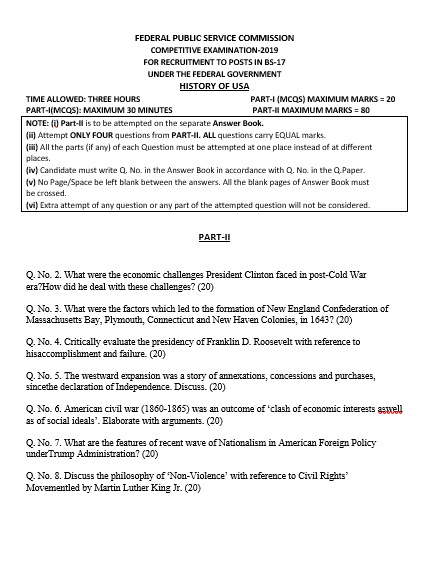History of USA 2019
Q. No. 2. What were the economic challenges President Clinton faced in the post-Cold War era? How did he deal with these challenges? (20)
Q. No. 3. What were the factors that led to the formation of the New England Confederation of Massachusetts Bay, Plymouth, Connecticut, and New Haven Colonies, in 1643? (20)
Q. No. 4. Critically evaluate the presidency of Franklin D. Roosevelt with reference to his accomplishments and failures. (20)
Q. No. 5. The westward expansion was a story of annexations, concessions, and purchases, since the Declaration of Independence. Discuss. (20)
Q. No. 6. The American Civil War (1860-1865) was an outcome of a ‘clash of economic interests as well as of social ideals’. Elaborate with arguments. (20)
Q. No. 7. What are the features of the recent wave of Nationalism in American Foreign Policy under the Trump Administration? (20)
Q. No. 8. Discuss the philosophy of ‘Non-Violence’ with reference to the Civil Rights Movement led by Martin Luther King Jr. (20)
Summaries of Questions:
Q. No. 2. What were the economic challenges President Clinton faced in the post-Cold War era? How did he deal with these challenges?
President Clinton faced a budget deficit, unemployment, and trade imbalances in the post-Cold War era. He addressed these by implementing fiscal reforms, signing NAFTA to boost trade, and fostering technological innovation, which led to economic growth and a budget surplus.
Q. No. 3. What were the factors that led to the formation of the New England Confederation of Massachusetts Bay, Plymouth, Connecticut, and New Haven Colonies in 1643?
The New England Confederation was formed to unite against Native American threats, resolve territorial disputes, and counter external threats from the Dutch and French. It was an early attempt at colonial unity, reflecting the colonies’ need for mutual defense and cooperation.
Q. No. 4. Critically evaluate the presidency of Franklin D. Roosevelt with reference to his accomplishments and failures.
Roosevelt’s presidency is marked by his New Deal programs that alleviated the Great Depression and his leadership during WWII. However, he faced criticism for overreach in government intervention and failing to address racial inequalities adequately during his tenure.
Q. No. 5. The westward expansion was a story of annexations, concessions, and purchases since the Declaration of Independence. Discuss.
The westward expansion included acquisitions like the Louisiana Purchase, the annexation of Texas, and the Oregon Treaty. These moves expanded US territory but often came at the expense of Native Americans and through conflicts with other nations, reflecting Manifest Destiny ideals.
Q. No. 6. The American Civil War (1860–1865) was an outcome of a ‘clash of economic interests as well as of social ideals.’ Elaborate with arguments.
The Civil War stemmed from economic differences between the industrial North and the agrarian, slave-dependent South. Socially, the North opposed slavery’s expansion, while the South defended it as a cultural and economic necessity, leading to irreconcilable divides.
Q. No. 7. What are the features of the recent wave of nationalism in American Foreign Policy under the Trump Administration?
Under Trump, American foreign policy embraced nationalism, focusing on “America First” principles. It prioritized trade protectionism, reduced multilateral engagements, and emphasized border security, leading to withdrawal from agreements like the Paris Climate Accord.
Q. No. 8. Discuss the philosophy of ‘Non-Violence’ with reference to the Civil Rights Movement led by Martin Luther King Jr.
Martin Luther King Jr. championed non-violence inspired by Gandhi’s principles. His peaceful protests, including the Montgomery Bus Boycott and March on Washington, were pivotal in challenging racial segregation and advocating for equal rights, achieving legislative victories like the Civil Rights Act of 1964.
